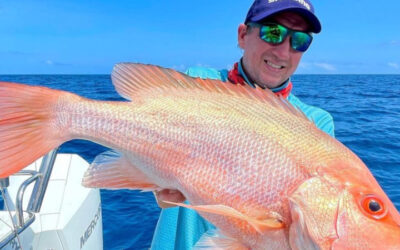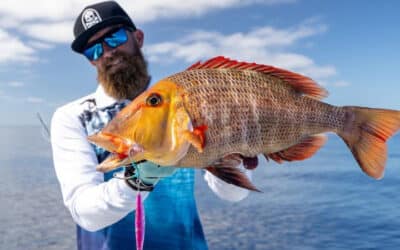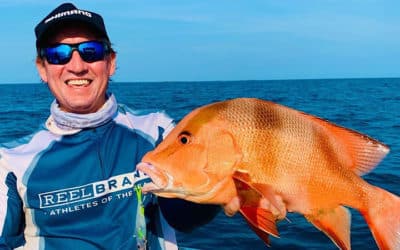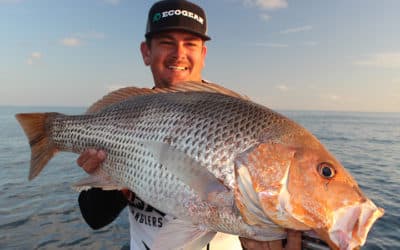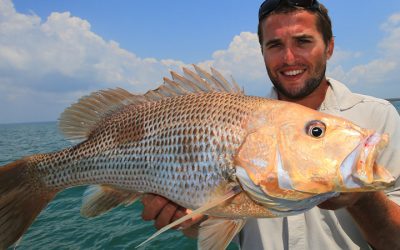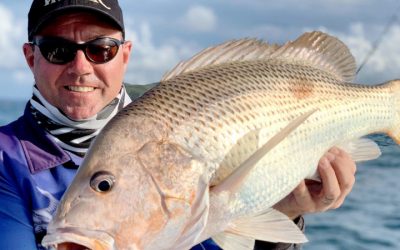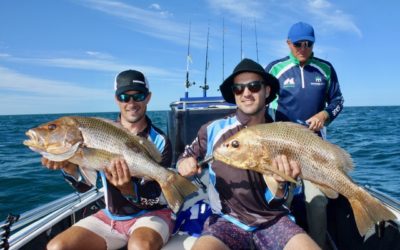Bomber Farrell returns to the ALF podcast, this time to explain his top five Groote Eylandt fishing experiences!
Fingermark Fishing: Unravelling the Secrets of The Golden Snapper

Fingermark fishing is a challenge for lure fishers who seek the thrill of targeting elusive and hard-fighting fish. Also known as Golden Snapper, fingermark bream and fingermark snapper, this species inhabits the tropical waters of the Indo-Pacific region and has earned a reputation for its beauty, unpredictable nature and delectable flesh.
So let’s dive into the world of fingermark fishing, exploring the techniques, strategies, and tackle required to hook these elusive beauties.
Understanding Fingermark Fishing
Fingermark inhabit a range of habitats including wrecks, ledges, rocky reefs, mangroves, and estuaries, often lurking near submerged structures or drop-offs. They’re often found well off the bottom and tend to be very mobile, moving between feeding and resting areas. They’re opportunistic predators, feeding on a variety of prey such as crustaceans, small fish, and molluscs.
Figuring out the seasonal patterns and preferred habitats of fingermark can be tricky as they are often transient. In many areas they can be targeted year-round, but fingermark fishing tends to be more effective during warmer months. Look for them around rocky outcrops, wrecks, headlands and submerged timber, particularly in areas where strong currents or tidal movements occur.
It can be hard to pick the best tides and times for fingermark fishing because of their mobile nature. But in any case, given the coastal setting most fishing opportunities tend to be dictated by the weather more than the tides. That said, fingermark are usually more active during periods with a lot of tidal movement.
Fingermark Fishing Tackle
Most lure anglers equip themselves with sturdy gear to match the power and resilience of these fish. Both overhead and spin gear can be used, provided you have a spool with a reasonable capacity for 20-30 lb braided line. They’re suckers for well presented slow pitch jigs, so specialist SPJ gear is also very effective in the right hands. Keep in mind that anything from stripies to GT, Cobia, mackerel and coral trout can snaffle a lure intended for fingermark, so tackle needs to be able to take some punishment.
The omnivorous diet of fingermark makes them susceptible to a range of baits and lures. Soft plastic lures, jerkbaits, and vibe-style lures in natural colors are great choices for fingermark fishing, as are various metal and octo-style jigs. Experimenting with different presentations and retrieving speeds can help determine the most effective approach on any given day.
Fingermark fish are a member of the Lutjanid family and are closely related to mangrove jack, red emperor, red bass and Papuan black bass. With that kind of lineage it’s no surprise that they are a fearsome opponent when hooked, renowned for their ability to smoke anglers in nearby structure. It’s one of the big attractions of fingermark fishing. Like a lot of fish, it can pay to avoid resorting to brute force, which often make the fish fish harder and ends with the line being parted over something sharp. A gentler, more disciplined approach can help coax them away from danger.
Conservation
Fingermark are a great eating fish, so definitly take one or two to eat. However, they are particularly susceptible to barotrauma, so be prepared to use a release weight to liberate fish taken from 10m or more of water.
ALF Episodes About Fingermark Fishing (aka Golden Snapper Fishing)
The ALF episodes below either focus 100% on how to catch fingermark using lures, or they have a significant component about targeting this species.
- Fingermark (golden snapper) are in the Lutjanid family and are closely related to mangrove jack, red emperor, red bass, nanygai and Papuan Black bass. Like their cousins, they are very hard fighting.
- In most parts of northern Australia fingermark fishing is a year-round option. But that dosn’t mean they’re easy or predictable!
- On the east coast of Australia, the best fingermark fishing often occurs over reefy, rubbly bottom that most anglers go past on their way to the reef.
- This is a species that will also come into quite shallow water to feed around headlands, islands, within estuaries and so forth.
- Fingermark are common in our tropical waters from central Queensland across the top end to the Kimberley. In the northern territory they’re known as golden snapper.
- They’re a slow growing fish that can take up to 30 years to reach their full size at around 95-100cm, reaching sexual maturity at around 50cm. The slow growth and late maturation makes them susceptible to overfishing.
- Fingermark are opportunistic predators and feed on a variety of prey including fish, crustaceans, and cephalopods.
- A common trait of Lutjanids is a susceptibility to barotrauma in fish taken from depths of 10 metres or more. released fish should be vented or returned using a release weight.
- Fingermark can change colour depending on their mood, health and environment. They can be anywhere from a yellowy bronze to almost silver with a large dark blotch beneath the back dorsal fin.
- Trolled or cast hard bodied diving lures are effective when fingermark fishing around inshore reefs and headlands.
- Soft plastic jerkbaits and paddletails can be deadly in most environments, but especially in shallower areas where they can easily reach the bottom.
- Metal jigs, particularly veritcally fished low pitch jigs are a favourite for fingermark fishing and also take a range of other species from deeper water.
- Soft Vibes are consistently effective, both in deep water and also on shallow reefs, headlands an in estuaries.
Episode 529: Mackay Slow Pitch Jigging With Mick Hassett
My Slow Pitch Jigging technique is something I’ve been working on lately – I’m on a steep curve. Not Mick Hassett though, he’s a machine with the SPJ and in today’s interview he shares a ton of pro tips.
Mindblowing Groote Eylandt Red Emperors On The Flats
Groote Eylandt is one of Australia’s fishing wonderlands – and one of the few places where sight casting to red emperor in crystal clear water is a thing.
Line Burning Fingermark Fishing Of Lucinda
Lucinda is a fisho’s haven and Liam Fitzpatrick knows the area extremely well.
Cobourg Peninsula’s Incredible Golden Snapper Fishing
The Coburg Peninsula is one of those super remote, must-go destinations for anyone wanting to experience the very best f tropical coastal fishing. And Hugh Gange has it all sown up.
Unleashing Fingermark Fishing: Emu Park’s Prized Golden Snapper
Fingermark bream are an amazing northern lure fishing target that pulls hard and looks great! Emu Park sponsored angler Liam Pascoe shares some great tips for getting onto quality fingermark on light gear.
Taming Weipa Fingermark Bream With Nathan Reardon
Nathan Reardon takes us on an adventure to far north Queensland where he targets fingermark bream in shallow water. As always, Nathan explains his preferred tackle and the techniques and lures he uses in this part of the world.

